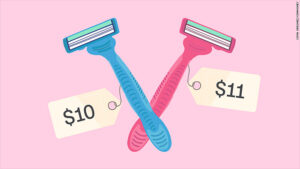
Zoe Stratos | Staff Columnist
The pink tax: the ongoing global phenomenon by which women’s goods and services cost more than men’s across all ages, regardless of similarities. Included in the price gap are children’s toys and accessories, children’s and adult’s clothing, hygiene products, senior health care products, dry cleaning and haircuts.
In a 2015 report released by the New York City Department of Consumer Affairs, studies showed that on average, products and services marketed to women cost more 42% of the time; whereas men overall pay more 18% of the time.
The largest discrepancy came with hygiene products. Sweeping the board in all but one category, shaving cream, women’s products cost an average of 13% more than men’s. The most staggering difference being that hair care —meaning shampoo and conditioner— cost an average of 48% more than men’s.
This gender-based pricing of goods and services has led to consumer realization of this pink tax, and women spend an estimated $1,351 more per year, according to a study conducted by the State of California in 1994.
But the issue of the pink tax continues to surge despite the discoveries in 1994 and 2015, barely making progress towards squashing the patriarchy of the consumer world.
During the summer of 2016, “The Pink Tax Repeal Act” was introduced to Congress proposing to end the pink tax on services and goods; moreover, later in 2016, a bi-partisan congressional report was released in opposition to the pink tax. However, shortly after introduction to Congress, talk of repeal diminished. The proposition was reintroduced two years later in 2018; however, results remained the same.
Despite the government’s lack of urgency on such a blatantly discriminatory circumstance, the pink tax opposers may be too ambitious in their request for repeal of the tax on services and goods.
Some steps have been taken to reduce public service price discrepancies, like dry cleaning, through state legislation prohibiting gender-based discrimination of pricing in companies. As far as retail goes, though, the supply chain becomes a long and confusing road for policymakers to travel on; it is hard to place the blame on one company, especially if the supply chain somehow makes it back to the government themselves.
If the pink tax opposers revised their proposition to only include services at first, the act would essentially be much easier to pass — not to mention enforce.
With the pink tax gone in the public service realm, women would be able to take clothing of similar style and material to a dry cleaning store without paying more money because the buttons are on the opposite side and require a higher labor effort.
The previous claim is unjustified because there is no true option for women when it comes to dry cleaning. The laundering and machine pressing process is made for male shirts, not female shirts. They do not fit, and therefore women are punished for a problem that is the fault of the company.
Not only this, but hair salons would be unable to charge women more for haircuts that are similar to men’s, thus forcing them to restrategize their pricing techniques through legitimate factors such as the length of time required to cut the hair.
Another problem sistering the pink tax is the sales tax placed on menstruation products: better known as the tampon tax.
The tampon tax is blatant gender-based discrimination practiced all over the world. Due to their classification as a “luxury item,” tampons, pads and other feminine hygiene products are subject to taxation in most countries. Women, though, do not consider these a “luxury.” Menstruation is an unstoppable part of human nature, so why should women have to pay so much for something they cannot control?
However, in 2015, Canada broke apart from the crowd passing into law an exemption of feminine products from federal taxation. With the right steps, the U.S. could come to this conclusion as well, making right all of the wrongs forced upon women in the consumer world.
Until then, the other solutions available are to buy men’s products, file for gender-based discrimination against local companies, and talk to lawmakers about changes in state legislation; it’s time to ax the pink tax.
